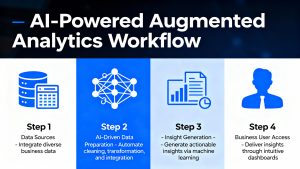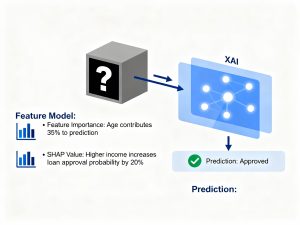
In today’s data-driven world, machine learning (ML) and artificial intelligence (AI) thrive on vast amounts of high-quality data. But collecting, cleaning, and securing real-world data can be expensive, time-consuming, and privacy-sensitive.
Enter synthetic data. It is artificially generated information that mimics real-world data without exposing sensitive details.
Synthetic data is revolutionizing industries from healthcare to finance by enabling model training, testing, and simulation at scale without legal or ethical constraints tied to real data.
In this blog, we will explore what synthetic data is, how it’s created, the types and benefits, and demonstrate with simple code examples how developers can generate and use it.
Distinguishing Between Synthetic and Real-World Data
Real-world data comes from direct user interaction or sensors, think e-commerce transactions, patient records, or IoT readings. It’s authentic but often noisy, biased, or restricted by privacy laws like GDPR or HIPAA.
Synthetic data, on the other hand, is machine-generated to imitate the structure, patterns, and statistical properties of real datasets without using any actual personal information.
Let’s compare them briefly through a practical example:
Example: Comparing Real and Synthetic Data in Python
import pandas as pd
import numpy as np
# Real-world dataset (simplified)
real_data = pd.DataFrame({
'age': [25, 32, 47, 51, 29],
'income': [35000, 54000, 76000, 82000, 42000],
'purchased': [0, 1, 1, 1, 0]
})
# Synthetic dataset generated using random sampling
synthetic_data = pd.DataFrame({
'age': np.random.normal(loc=37, scale=10, size=5).astype(int),
'income': np.random.normal(loc=60000, scale=15000, size=5).astype(int),
'purchased': np.random.choice([0, 1], size=5)
})
print("Real Data:\n", real_data)
print("\nSynthetic Data:\n", synthetic_data)This code mimics real customer data but none of the entries come from actual users. The key takeaway: synthetic data should statistically resemble real data, not replicate it.
Types of Synthetic Data
Synthetic data can take multiple forms depending on what it represents and how it’s generated. The main categories include:
- Tabular Data – Used in finance, retail, or HR systems (e.g., transaction records, sales data).
Generated via statistical models or GANs (Generative Adversarial Networks). - Image Data – Synthetic images for computer vision models.
Used in autonomous vehicles or medical imaging. - Text Data – AI-generated sentences for NLP training or chatbot development.
Produced using transformer models like GPT or BERT. - Time-Series Data – Simulated sensor readings or stock price movements.
Common in IoT and financial analytics.
Example: Generating Synthetic Time-Series Data
import numpy as np
import pandas as pd
time = pd.date_range(start='2024-01-01', periods=10, freq='D')
temperature = 25 + np.random.normal(0, 1, 10).cumsum()
synthetic_time_series = pd.DataFrame({'Date': time, 'Temperature': temperature})
print(synthetic_time_series)This creates fake yet realistic temperature readings that follow natural fluctuations perfect for testing IoT dashboards or anomaly detection models.
How Synthetic Data Is Generated
Synthetic data can be created using multiple approaches depending on the complexity of the data and the desired accuracy:
1. Rule-Based Generation
Developers manually define data distributions, ranges, and constraints.
Best suited for testing or database seeding.
import random
users = []
for _ in range(5):
users.append({
"id": random.randint(1000, 9999),
"gender": random.choice(["Male", "Female"]),
"age": random.randint(18, 60),
"country": random.choice(["USA", "India", "UK"])
})
print(users)2. Statistical Modeling
Based on probability distributions that mirror real-world data characteristics.
Example using NumPy for synthetic salary data:
salaries = np.random.lognormal(mean=10, sigma=0.3, size=1000)3. Machine Learning Models
AI-driven techniques such as GANs (Generative Adversarial Networks) or Variational Autoencoders (VAEs) can create highly realistic data.
Example: Simple GAN-like Data Simulation (conceptual)
from sklearn.datasets import make_classification
import pandas as pd
X, y = make_classification(n_samples=500, n_features=4, random_state=42)
synthetic_df = pd.DataFrame(X, columns=["feature1", "feature2", "feature3", "feature4"])
synthetic_df["label"] = y
print(synthetic_df.head())This uses scikit-learn to simulate synthetic classification data for model training.
Key Use Cases and Applications
Synthetic data is being adopted across diverse industries for both privacy protection and innovation acceleration:
- Healthcare:
Simulate patient data for training diagnostic models without exposing actual medical records. - Finance:
Generate transaction data for fraud detection models without real account details. - Autonomous Vehicles:
Train computer vision systems on synthetic roads and pedestrians for safer driving models. - Cybersecurity:
Create attack simulation datasets for intrusion detection. - Software Testing:
Populate databases with realistic mock data before real users join the system.
Benefits of Synthetic Data
- Privacy Preservation:
Since no real user information is used, synthetic data avoids GDPR or HIPAA violations. - Scalability:
You can generate millions of data points programmatically in seconds. - Bias Reduction:
Properly designed synthetic datasets can balance class distributions, removing real-world biases. - Faster Prototyping:
Developers can start building and testing ML pipelines before real data arrives.
Example: Balancing Classes in Synthetic Data
from imblearn.datasets import make_imbalance
from sklearn.datasets import make_classification
X, y = make_classification(n_classes=2, weights=[0.9, 0.1], n_samples=1000)
print("Before balancing:", sum(y == 1))
# Create a balanced synthetic dataset
X_balanced, y_balanced = make_classification(n_classes=2, weights=[0.5, 0.5], n_samples=1000)
print("After balancing:", sum(y_balanced == 1))This ensures fairer datasets for model training.
Limitations of Synthetic Data
While powerful, synthetic data isn’t perfect. Some challenges include:
- Lack of Realism: Artificial data might miss subtle real-world correlations.
- Model Overfitting: Poorly generated synthetic data can bias models toward artificial patterns.
- Validation Challenges: It’s difficult to assess quality without comparing against real datasets.
- Regulatory Acceptance: Some industries (like healthcare) still prefer real-world evidence for compliance.
Conclusion
Synthetic data is reshaping how developers, data scientists, and organizations approach AI and analytics. It serves as a bridge between innovation and privacy, enabling faster, safer experimentation without risking sensitive information.
By understanding its generation methods, strengths, and pitfalls, developers can confidently integrate synthetic data into workflows from model training and A/B testing to API validation and simulation environments.
In essence, synthetic data is not a replacement for real data, but a powerful complement. When combined with real-world datasets and proper validation, it can supercharge data pipelines, accelerate AI research, and make privacy-first innovation a reality.
As we move toward a future powered by AI-generated intelligence, synthetic data will be the invisible engine driving safer, smarter, and faster digital transformation.



